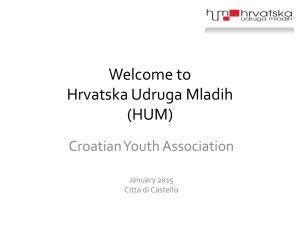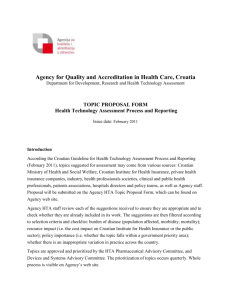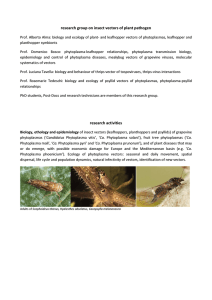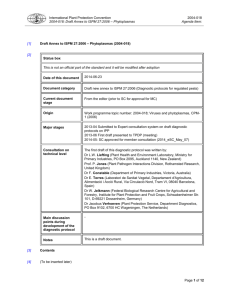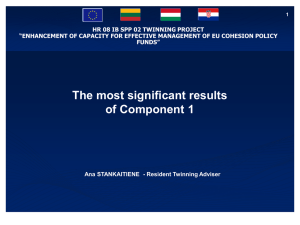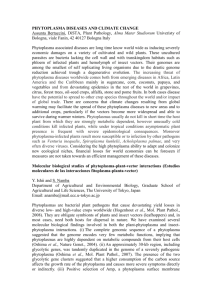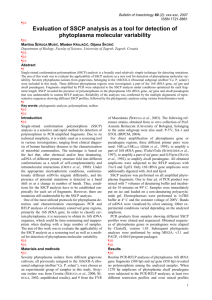phytoplasmas and their potential vectors in vineyards of indigenous
advertisement
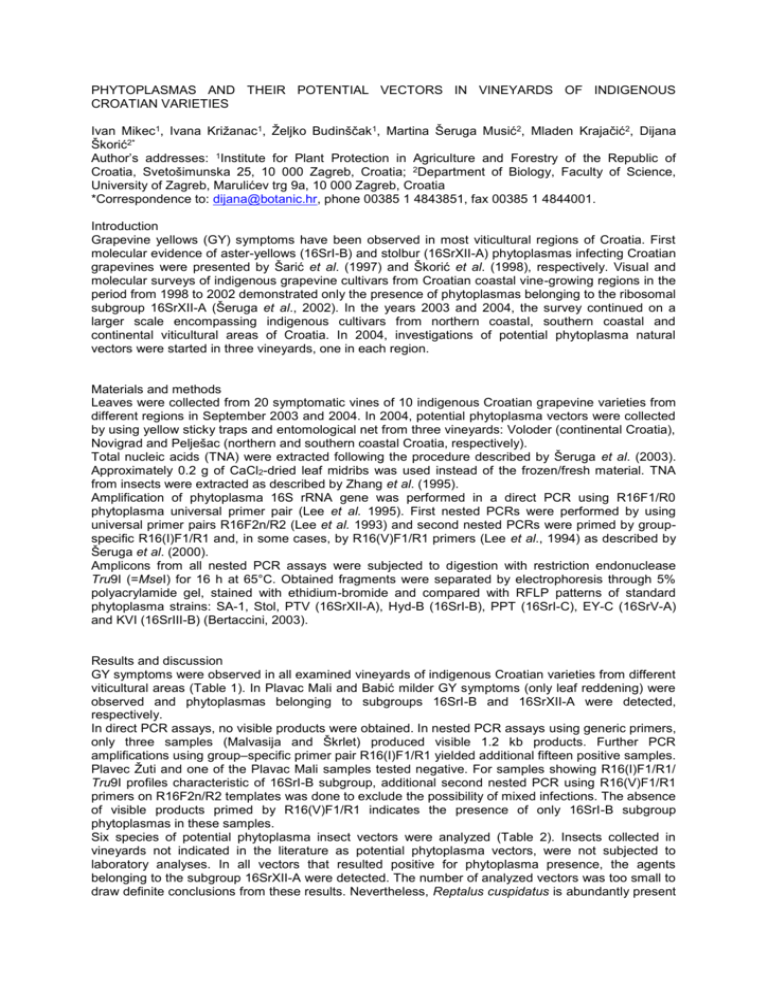
PHYTOPLASMAS AND THEIR POTENTIAL VECTORS IN VINEYARDS OF INDIGENOUS CROATIAN VARIETIES Ivan Mikec1, Ivana Križanac1, Željko Budinščak1, Martina Šeruga Musić2, Mladen Krajačić2, Dijana Škorić2* Author’s addresses: 1Institute for Plant Protection in Agriculture and Forestry of the Republic of Croatia, Svetošimunska 25, 10 000 Zagreb, Croatia; 2Department of Biology, Faculty of Science, University of Zagreb, Marulićev trg 9a, 10 000 Zagreb, Croatia *Correspondence to: dijana@botanic.hr, phone 00385 1 4843851, fax 00385 1 4844001. Introduction Grapevine yellows (GY) symptoms have been observed in most viticultural regions of Croatia. First molecular evidence of aster-yellows (16SrI-B) and stolbur (16SrXII-A) phytoplasmas infecting Croatian grapevines were presented by Šarić et al. (1997) and Škorić et al. (1998), respectively. Visual and molecular surveys of indigenous grapevine cultivars from Croatian coastal vine-growing regions in the period from 1998 to 2002 demonstrated only the presence of phytoplasmas belonging to the ribosomal subgroup 16SrXII-A (Šeruga et al., 2002). In the years 2003 and 2004, the survey continued on a larger scale encompassing indigenous cultivars from northern coastal, southern coastal and continental viticultural areas of Croatia. In 2004, investigations of potential phytoplasma natural vectors were started in three vineyards, one in each region. Materials and methods Leaves were collected from 20 symptomatic vines of 10 indigenous Croatian grapevine varieties from different regions in September 2003 and 2004. In 2004, potential phytoplasma vectors were collected by using yellow sticky traps and entomological net from three vineyards: Voloder (continental Croatia), Novigrad and Pelješac (northern and southern coastal Croatia, respectively). Total nucleic acids (TNA) were extracted following the procedure described by Šeruga et al. (2003). Approximately 0.2 g of CaCl2-dried leaf midribs was used instead of the frozen/fresh material. TNA from insects were extracted as described by Zhang et al. (1995). Amplification of phytoplasma 16S rRNA gene was performed in a direct PCR using R16F1/R0 phytoplasma universal primer pair (Lee et al. 1995). First nested PCRs were performed by using universal primer pairs R16F2n/R2 (Lee et al. 1993) and second nested PCRs were primed by groupspecific R16(I)F1/R1 and, in some cases, by R16(V)F1/R1 primers (Lee et al., 1994) as described by Šeruga et al. (2000). Amplicons from all nested PCR assays were subjected to digestion with restriction endonuclease Tru9I (=MseI) for 16 h at 65°C. Obtained fragments were separated by electrophoresis through 5% polyacrylamide gel, stained with ethidium-bromide and compared with RFLP patterns of standard phytoplasma strains: SA-1, Stol, PTV (16SrXII-A), Hyd-B (16SrI-B), PPT (16SrI-C), EY-C (16SrV-A) and KVI (16SrIII-B) (Bertaccini, 2003). Results and discussion GY symptoms were observed in all examined vineyards of indigenous Croatian varieties from different viticultural areas (Table 1). In Plavac Mali and Babić milder GY symptoms (only leaf reddening) were observed and phytoplasmas belonging to subgroups 16SrI-B and 16SrXII-A were detected, respectively. In direct PCR assays, no visible products were obtained. In nested PCR assays using generic primers, only three samples (Malvasija and Škrlet) produced visible 1.2 kb products. Further PCR amplifications using group–specific primer pair R16(I)F1/R1 yielded additional fifteen positive samples. Plavec Žuti and one of the Plavac Mali samples tested negative. For samples showing R16(I)F1/R1/ Tru9I profiles characteristic of 16SrI-B subgroup, additional second nested PCR using R16(V)F1/R1 primers on R16F2n/R2 templates was done to exclude the possibility of mixed infections. The absence of visible products primed by R16(V)F1/R1 indicates the presence of only 16SrI-B subgroup phytoplasmas in these samples. Six species of potential phytoplasma insect vectors were analyzed (Table 2). Insects collected in vineyards not indicated in the literature as potential phytoplasma vectors, were not subjected to laboratory analyses. In all vectors that resulted positive for phytoplasma presence, the agents belonging to the subgroup 16SrXII-A were detected. The number of analyzed vectors was too small to draw definite conclusions from these results. Nevertheless, Reptalus cuspidatus is abundantly present and consistently harbors phytoplasmas from the subgroup 16SrXII-A suggesting its important role in some of the pathosystems indigenous vines – vector – herbaceous hosts. Although our previous research (not shown) preformed on a limited number of vineyard weeds indicates the involvement of Taraxacum officinale, Stellaria media and Convovulus arvensis, the definite role of these, and possibly other weeds for the molecular epidemiology of phytoplasmas in Croatian indigenous vines remains to be determined. Acknowledgements The Croatian Ministry of Agriculture, Forestry and Water management financed this research. References Lee, I.M., Bertaccini, A., Vibio, M. & Gundersen, D.E., 1995. Detection of multiple phytoplasmas in perennial fruit trees with decline symptoms in Italy. Phytopathology 85, 728-735. Lee, I.M., Gundersen, D.E., Hammond, R.W. & Davis, R.E., 1994. Use of mycoplasmalike organism (MLO) groupspecific oligonucleotid primers for nested-PCR assays to detect mixed-MLO infections in a single host plant. Phytopathology 84, 559-566. Lee, I.M., Hammond, R.W., Davis, R.E. & Gundersen, D.E., 1993. Universal amplification and analysis of pathogen 16S rDNA for classification and identification of mycoplasmalike organism. Phytopathology 83, 834-842. Šarić, A., Škorić, D., Bertaccini, A., Vibio, M. & Murari E., 1997. Molecular detection of phytoplasmas infecting grapevines in Slovenia and Croatia. Proc. 12th Meet. ICVG 1997, Lisbon, Portugal 77-78. Šeruga, M., Ćurković Perica, M., Škorić, D., Kozina, B., Mirošević, N., Šarić, A., Bertaccini, A. & Krajačić, M., 2000. Geographical distribution of bois noir phytoplasmas infecting grapevines in Croatia. Journal of Phytopathology 148, 239-242. Šeruga, M., Škorić, D., Kozina, B. & Krajačić, M., 2002. Phytoplasmas in Croatian indigenous grapevine cultivars. Proc. 14th Int. Con. IOM 2002, Vienna, Austria. Šeruga, M., Škorić, D., Botti, S., Paltrinieri, S., Juretić, N. & Bertaccini, A. F., 2003. Molecular characterization of a phytoplasma from the aster yellows (16SrI) group naturally infecting Populus nigra L. 'Italica' trees in Croatia. Forest Pathology 33, 113-125. Škorić, D., Šarić, A., Vibio, M., Murari, E., Krajačić, M. & Bertaccini, A., 1998. Molecular identification and seasonal monitoring of phytoplasmas infecting Croatian grapevines. Vitis 37, 171-175. Zhang, Y.P., Uyemoto, J.K. & Kirkpatrick, B.C., 1995. A rapid, small scale procedure for extracting virus, viroid, MLO and bacterial nucleic acid from plants for analysis by PCR. Phytopathology 85, 1205. Bertaccini, A., 2003. URL: http://137.204.42.130/person/collection-september_2003.pdf. Date of last accession: June 8, 2004. Table 1. Phytoplasma identification in grapevine samples Year Region Vineyard Cultivar Northern coastal Rovinj Vrbnik Pelješac Čara Lumbarda Primošten Zelina Nespeš Voloder Malvasija Žlahtina Plavac Mali Pošip Grk Babić Kraljevina Kraljevina Moslavac Kraljevina Plavec Žuti Plavac Mali Plavac Mali Pošip Škrlet Southern coastal 2004 Continental Križevci 2003 Southern coastal Continental Pelješac Čara Voloder Number of samples 2 2 1 1 1 2 2 1 1 1 1 2 1 1 1 R16F2nR2/Tru9I R16(I)F1/R1/Tru9I 16SrXII-A 16SrXII-A not tested 16SrXII-A 16SrI-B 16SrXII-A 16SrXII-A 16SrXII-A 16SrXII-A 16SrXII-A 16SrI-B 16SrXII-A 16SrI-B 16SrI-B not tested Table 2. Phytoplasma identification in insect samples Region Vineyard Northern coastal Novigrad Southern coastal Pelješac Continental Voloder Species Reptalus cuspidatus Scaphoideus titanus Metcalfa pruinosa Empoasca vitis Arboridia dalmatina Reptalus cuspidatus Reptalus cuspidatus Cicadella viridis Reptalus panzeri Hyalestes obsoletus R16F2nR2/Tru9I not tested not tested - R16(I)F1/R1/Tru9I 16SrXII-A - 16SrXII-A 16SrXII-A -

